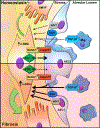Developmental pathways in the pathogenesis of lung fibrosis
- PMID: 30130563
- PMCID: PMC6374163
- DOI: 10.1016/j.mam.2018.08.004
Developmental pathways in the pathogenesis of lung fibrosis
Abstract
Idiopathic pulmonary fibrosis (IPF) is a progressive and terminal lung disease with no known cure. IPF is a disease of aging, with median age of diagnosis over 65 years. Median survival is between 3 and 5 years after diagnosis. IPF is characterized primarily by excessive deposition of extracellular matrix (ECM) proteins by activated lung fibroblasts and myofibroblasts, resulting in reduced gas exchange and impaired pulmonary function. Growing evidence supports the concept of a pro-fibrotic environment orchestrated by underlying factors such as genetic predisposition, chronic injury and aging, oxidative stress, and impaired regenerative responses may account for disease development and persistence. Currently, two FDA approved drugs have limited efficacy in the treatment of IPF. Many of the genes and gene networks associated with lung development are induced or activated in IPF. In this review, we analyze current knowledge in the field, gained from both basic and clinical research, to provide new insights into the disease process, and potential approaches to treatment of pulmonary fibrosis.
Keywords: Antagonistic pleiotropy; Development; Fibroblast growth factor (FGF); Fibrosis; Hippo; Lung; Notch; Platelet derived growth factor (PDGF); Sonic hedgehog (SHH); Transforming growth factor-β (TGF-β); Wnt.
Copyright © 2018. Published by Elsevier Ltd.
Figures
References
-
- Akhmetshina A, Palumbo K, Dees C, Bergmann C, Venalis P, Zerr P, Horn A, Kireva T, Beyer C, Zwerina J, Schneider H, Sadowski A, Riener MO, MacDougald OA, Distler O, Schett G, Distler JH, 2012. Activation of canonical Wnt signalling is required for TGF-beta-mediated fibrosis. Nat Commun 3, 735. - PMC - PubMed
-
- Alejandre-Alcazar MA, Michiels-Corsten M, Vicencio AG, Reiss I, Ryu J, de Krijger RR, Haddad GG, Tibboel D, Seeger W, Eickelberg O, Morty RE, 2008. TGF-beta signaling is dynamically regulated during the alveolarization of rodent and human lungs. Dev Dyn 237 (1), 259–269. - PubMed
Publication types
MeSH terms
Substances
Grants and funding
LinkOut - more resources
Full Text Sources
Other Literature Sources
Medical



